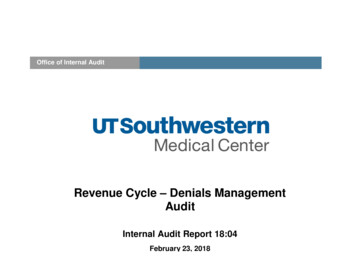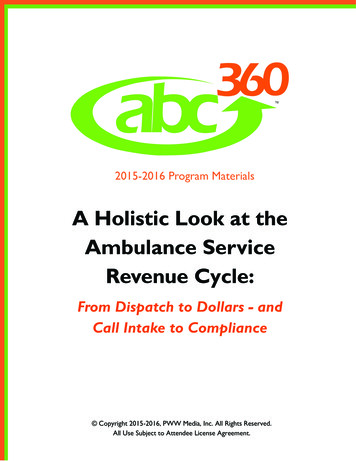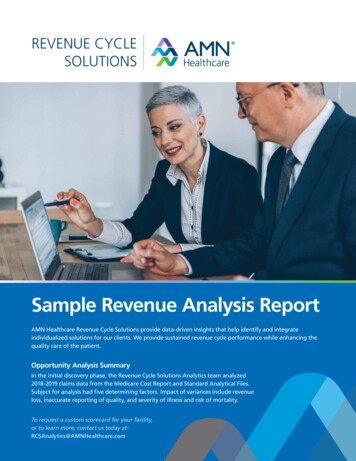
Transcription
Revenue Cycle:Reimagining for aMore Efficient TomorrowHow to Play Ball with PriorAuthorizationsThursday, January 17th, 2019Gillette Stadium ClubhousePeter AngerhoferPrincipalColburn Hill GroupRevenue Cycle:Reimagining for aMore Efficient TomorrowAGENDA Huddle Up! Finding the Root Cause Common Scenarios1.2.3.4.5.Starting Out BehindPayers take too long to respondPre-Auth’ed Service Denied AnywayWe can’t keep up!Denials are YOUR problem1
Revenue Cycle:Reimagining for aMore Efficient TomorrowHuddle up!Historically, responsibility for authorizations has beendistributed across many players – physician offices, casemanagement, patient access, etc. This decentralization makesit a struggle to keep track of the rules and guidelines.Payers create new prior authorization requirements by addinglevels of complexity and various turn around timerequirements that are difficult to navigate.Being on losing side of the final score means administrativeburdens, loss of revenue, and poor patient experience due todelays in care.Revenue Cycle:Reimagining for aMore Efficient TomorrowNew interest in the problemAs the trend in cost containment on the payer sidecontinues to increase, time and resource demands onPhysicians is impacting their ability to deliver care. Keystakeholders such as the American Medical Association(AMA) and the American Academy of Family Physicians(AAFP) have gotten involved in calling for reform, validatingwhat Patient Access departments have struggled with formore than a decade!!2
Revenue Cycle:Reimagining for aMore Efficient TomorrowAMA and AAFP“The AMA believes that prior authorization is overused andthat existing processes are costly, inefficient, opaque andresponsible for patient care delays”-AMA“The very manual, time-consuming processes used in priorauthorization programs burden family physicians, divertvaluable resources away from direct patient care and caninadvertently lead to negative patient outcomes.”-AAFPRevenue Cycle:Reimagining for aMore Efficient TomorrowPrior Authorizations – Response TimeAMA gathered meaningful statistics on the impact to patientcare. The average hospitalscheduling process canadd anywhere from 1 to 3additional days to theprocess. The average days outscheduling isapproximately 72 hours inmany facilities.Source:2017 AMA Prior Authorization Physician Survey3
Revenue Cycle:Reimagining for aMore Efficient TomorrowPrior Authorizations – Care Delays Care delays are not new! The alternative significant financial drain,ultimately costing theservicing healthcareorganization. Question: What is yourDelay/deny policy?Source:2017 AMA Prior Authorization Physician SurveyRevenue Cycle:Reimagining for aMore Efficient TomorrowPrior Authorizations - Treatment Cancellations and rescheduling Tracking physician orders Denied priorauthorizations and theuse of WaiversSource:2017 AMA Prior Authorization Physician Survey4
Revenue Cycle:Reimagining for aMore Efficient TomorrowPrior Authorizations – Clinical Outcomes If not diagnosed now then when? Inability to carry outtreatment as initiallyprescribed Impact of delayed ‘elective’surgical proceduresSource:2017 AMA Prior Authorization Physician SurveyRevenue Cycle:Reimagining for aMore Efficient TomorrowPrior Authorizations – Recognition of costsThe GOOD news here is that we all agree! Navigating priorauthorizations is painful at best. Everyone wants to improve thepractice and the new buzzword is REFORM!The current practice of securing prior-authorizations: Is costly to organizations by way of administrative costs Is costly to everyone involved by way of lost revenue Is delaying patient care and degrades health outcomes Is costly to overall patient experience5
Revenue Cycle:Reimagining for aMore Efficient TomorrowReform might be on the wayBUT WAIT!! Reform takes time. It COULD happen In the meantime, there aremore timely steps to taketowards expeditingperformance improvement:but about thesame timeBrady gives uphis avocado icecream. Know where to look forgaps & process deficiencies Take immediate actiondiagnose and repair anyfracturesor Gronkdecides tokeep his shirton. Get a line of site on bestpractice and create a planto move towards itRevenue Cycle:Reimagining for aMore Efficient TomorrowAGENDA Huddle Up! Finding the Root Cause Common Scenarios1.2.3.4.5.Starting Out BehindPayers take too long to respondPre-Auth’ed Service Denied AnywayWe can’t keep up!Denials are YOUR problem6
Revenue Cycle:Reimagining for aMore Efficient TomorrowFinding the Root CauseThe only way to change the performance is to isolate the rootcauses which are creating bad outcomes before attempting toimprove.The following are five common examples of gaps found in priorauthorization departments, but the list is not all inclusive.Much like football, financial clearance is a team effort but alsorequires leadership.Revenue Cycle:Reimagining for aMore Efficient TomorrowFinding the Root CauseStages of performance improvement: Getting your hands on the right data is a completed pass Analyzing it is a first down A good working theory or conclusion is reaching the goal line Better performance is the TOUCHDOWN!!!A few mistakes to avoid in this phase DON’T Look to technology & vendor ROI to solve all of your problems Leave out the financials: what is impact & cost? Hand off the problem if “it isn’t your department”7
Revenue Cycle:Reimagining for aMore Efficient TomorrowFinding the Root CauseLooking at only data for your root cause could put youback on the bench without scoring. Take time to size up theissue and be hands on before giving your problem a name.Good habits to have include DO Review data in different ways: payer trends etc., (80/20) Observe/walk through the process: beginning to end Take ample time to REVIEW barriers with front line staff in detail Perform and assign account reviews: understand what you are seeing Include upstream & downstream in financial impact calculationsRevenue Cycle:Reimagining for aMore Efficient TomorrowAGENDA Huddle Up! Finding the Root Cause Common Scenarios1.2.3.4.5.Starting Out BehindPayers take too long to respondPre-Auth’ed Service Denied AnywayWe can’t keep up!Denials are YOUR problem8
Revenue Cycle:Reimagining for aMore Efficient TomorrowScenario 1Starting Out BehindFinancial Clearance staff do not have sufficient time toobtain timely prior-authorizations.Common Scenario:Financial Clearance staff consistently struggle to achieve their “days out” metric.Disconnected scheduling departments focus on “filling open blocks” & TAT times.Ultimately patients are cancelled, rescheduled and even provided service withoutproper prior-authorization in place. Scheduling department routinely schedules patients in “first available” time slots Not enough insight into prior-authorization requirements Poor patient demographic/insurance capture squeezes turn around times Financial clearance staff become inefficientRevenue Cycle:Reimagining for aMore Efficient TomorrowStarting Out BehindNeed to manage the timing of scheduling andexpedite clearance where necessarySolutionEase Cost Time Develop a Matrix detailing payer/service priorauthorization requirements & turn around times Educate schedulers on correct demographic entry Look for integration between scheduling system andregistration system Update job description from ‘scheduler’ to ‘schegistrar’ Centralize scheduling staff under Patient Accessleadership9
Revenue Cycle:Reimagining for aAGENDAMore Efficient Tomorrow Huddle Up! Finding the Root Cause Common Scenarios1.2.3.4.5.Starting Out BehindPayers take too long to respondPre-Auth’ed Service Denied AnywayWe can’t keep up!Denials are YOUR problemRevenue Cycle:Reimagining for aMore Efficient TomorrowScenario 2Payers take too long to respondPrior-authorization requests are being denied anddelayed.Common Scenario:The prior-authorization department is meeting the “days out” goal of 5 days,however, patients are consistently being cancelled and rescheduled for theirservices.Gaps/area of deficiency: Payers are returning higher than average requests for Peer to Peer reviews Prior-authorization requests are coming back as denied10
Revenue Cycle:Payers take too long to respondReimagining for aMore Efficient TomorrowEducate and Communicate about prior authorizationrequirementsSolutionEase Cost Time Track prior-authorization requests & status outcomes Review payer’s contractual obligation Sit down with Contract Management team & PayerRep Centralize effort of starting & obtaining priorauthorizations (VERSUS verifying if they are on file) Employ clinical/coding credentialed staff Procure & implement Prior-authorization software thatwill map payer clinical requirementsRevenue Cycle:Reimagining for aMore Efficient TomorrowAGENDA Huddle Up! Finding the Root Cause Common Scenarios1.2.3.4.5.Starting Out BehindPayers take too long to respondPre-Auth’ed Service Denied AnywayWe can’t keep up!Denials are YOUR problem11
Revenue Cycle:Scenario 3Pre-Auth’ed Service Denied anywayReimagining for aMore Efficient TomorrowServices performed do not match prior-authorization onfile Common Scenario:The Business office is reporting a trend of adjusted accounts for the lack ofprior-authorization. A patient account review reveals that authorizationnumbers & details are noted in the system as they should be. Furtherreview reveals that the services ordered and authorized prior to serviceare different than the services rendered.Gaps/area of deficiency:Services ordered and authorized prior to service are different than theservices rendered.23Revenue Cycle:Reimagining for aMore Efficient TomorrowPre-Auth’ed Service Denied anywayNeed to develop a process to minimize mismatches oridentify them as soon as possibleSolutionEase Cost Time Gather stakeholders to review samples of the issueand develop charter for future prevention Work with internal IT resources to develop a reportthat enables manual reconciliation between orderedvs. performed services Procure & implement Prior-authorization software thatincludes reconciling ordered vs. performed services12
Revenue Cycle:Reimagining for aAGENDAMore Efficient Tomorrow Huddle Up! Finding the Root Cause Common Scenarios1.2.3.4.5.Starting Out BehindPayers take too long to respondPre-Auth’ed Service Denied AnywayWe can’t keep up!Denials are YOUR problemScenario 4We can’t keep up!Revenue Cycle:Reimagining for aMore Efficient TomorrowUnder resourcing leads to backlogs, poor quality and lostrevenue Common Scenario:The prior-authorization department struggles to keep up with theirworkload. The Manager of the team is consistently moving staff workassignments to cover the work and approving overtime. Staff work out ofmultiple systems, not all of the team members are equally equipped tocomplete all types of accounts due to access and training. There is no roomto add staff or upgrade software.Gaps/area of deficiency:The department is lacking resourcesStaff do not have the training or the tools to complete their jobs.13
Revenue Cycle:Reimagining for aWe can’t keep up!More Efficient TomorrowIn-house IT solutions: utilizing extensions currentlyavailable within your existing registration technologyPROSCan save time & costLimited resultsCONSSuccess with this type of strategy can be “trial &error”Mapping & dictionary dependent w/variablesuccessExamples:GE Centricity/IDX: Enterprise Task Manager(ETM)McKesson STAR: Financial ClearanceWorkstationRevenue Cycle:Reimagining for aWe can’t keep up!More Efficient TomorrowAutomation: Going to market to procure & implementautomation technologyIncreasedPROS visibility/reconciliationIncreased process efficiencyDecreased payroll costNo ‘all in one’ solution in the market YETIntegration can be trickyBEWARE!The sales pitch ALWAYS sounds AMAZING!!!Allocate the right expertise & resources to projectAsk for current client demos with same ADTsystemExamples:CONSPriorAuth NowExperian PassportAvaility14
Revenue Cycle:Reimagining for aMore Efficient TomorrowWe can’t keep up!Outsourcing: Partnering with a vendor to take on themanagement & outcome of the processPROSFrees up Management team to drive resultsGives access to enhanced reporting &metricsOpportunity for better performanceAbility to ‘customize’ service is limitedCan be timeconsuming‘Perfection’ comes over timeBEWARE!Customization is not necessarily a GOOD thingRegistration foundation could troubleTurn over rates are the silent killerExamples:CONSKey ProR1AthenaRevenue Cycle:Reimagining for aMore Efficient TomorrowAGENDA Huddle Up! Finding the Root Cause Common Scenarios1.2.3.4.5.Starting Out BehindPayers take too long to respondPre-Auth’ed Service Denied AnywayWe can’t keep up!Denials are YOUR problem15
Scenario 5Denials are YOUR problemRevenue Cycle:Reimagining for aMore Efficient TomorrowInadequate insight to denials delays true performanceimprovement and puts further reimbursement at risk.Common Scenario:There is a lack of clear performance indicators for prior-authorization work.Stakeholder departments (such as radiology and surgery) are reaching out foranswers to denied pharmacy charges, were the other services on the accountpaid? The Surgeons and Radiologists state that they are being denied paymentfor their professional fees.Gaps/area of deficiency:Not enough focus around denial prevention and performancePreventable denials are undetected until write off is imminent31Revenue Cycle:Reimagining for aMore Efficient TomorrowDenials are YOUR problemSolutionEase Cost Time Obtain and use 835 denial data to analyze andprioritize areas of opportunity Implement formal patient access denials policy thatrequires approval to adjust fatal denials Attend and participate with organization’s denialcommittee If there is no denials committee, be an advocate andstart the conversation Use a business intelligence software package forreporting and visualization16
Revenue Cycle:Reimagining for aMore Efficient TomorrowDenials are YOUR problemDenials Committee The committee is typically established by the RC director andfacilitated by the billing office. Meets on a regular monthly basis Measure against Industry Standards when it comes toassessing performance Have a goal established for each categoryExample of Measuring to Industry Example of Goals 33Revenue Cycle:Reimagining for aMore Efficient TomorrowDenials are YOUR problemBest Practice: Utilize 835 denial data to analyze and prioritize areasof opportunityFirst Step: analyze by denial category to provide insight to the scope of the issue andassist in prioritization In this example, authorization denials account for 4% of the overall account populationand 35% of the total dollars It is the priority for FE denials over eligibility and coordination of benefits3417
Revenue Cycle:Reimagining for aMore Efficient TomorrowDenials are YOUR problemBest Practice: Utilize 835 denial data to analyze and prioritizeareas of opportunityNext Step: take the biggest opportunity (authorizations) and drill down to thenext biggest opportunity to analyze further 35Revenue Cycle:Reimagining for aMore Efficient TomorrowDenials are YOUR problemBest Practice: Utilize 835 denial data to analyze and prioritizeareas of opportunityLast step: Perform & record account review data to get to & follow up on Finding theRoot Cause 3618
Revenue Cycle:Reimagining for aMore Efficient TomorrowConclusions Technology, vendors, and data must fit with process Be hands on – observe for yourself, dig into detailedoperations Follow root causes to identify the gaps Make a conscious decision on good/better/beststrategies for improving operations Be data driven in identifying opportunities andworking with stakeholders37Revenue Cycle:Reimagining for aMore Efficient TomorrowQuestions?Peter AngerhoferColburn Hill Grouppangerho@colburnhill.com603-969-40063819
Revenue Cycle: Reimagining for a More Efficient Tomorrow AGENDA Huddle Up! Finding the Root Cause Common Scenarios 1.Starting Out Behind 2.Payers take too long to respond 3.Pre-Auth'edService Denied Anyway 4.We can't keep up! 5.Denials are YOUR problem Revenue Cycle: Reimagining for a More Efficient Tomorrow Scenario 2










